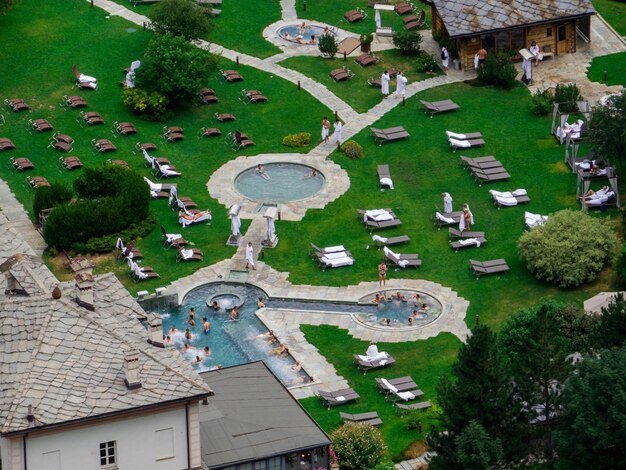Investing in the Longevity Economy: Healthcare & Senior Living Opportunities

Investing in the longevity economy presents significant opportunities within healthcare and senior living, driven by the increasing aging population and the rising demand for specialized services and innovative solutions.
The **investing in the longevity economy** is becoming increasingly attractive as the world’s population ages, creating unique opportunities in healthcare and senior living.
Understanding the Longevity Economy
The longevity economy represents the economic activities and opportunities driven by the needs and preferences of older adults. It’s a growing sector fueled by increased life expectancy and a desire for higher quality of life in later years.
This demographic shift opens up avenues for investors looking to capitalize on the increasing demand for products and services tailored to seniors. Healthcare and senior living are two key areas poised for substantial growth.
The Rise of the Aging Population
The global population is aging at an unprecedented rate. This demographic trend creates a surge in demand for age-related services and products, making the longevity economy a focal point for investment.
Key Drivers of the Longevity Economy
- Increased life expectancy worldwide.
- Growing demand for specialized healthcare services.
- Technological advancements in age-related care.
- Shifting attitudes towards aging and retirement.
Understanding these drivers is crucial for successful investment strategies in this expanding market. Focusing on innovation and tailored solutions can lead to substantial returns.

In conclusion, the longevity economy presents a robust investment landscape driven by demographic shifts and technological advancements. Targeting healthcare and senior living with innovative solutions can unlock significant opportunities in this expanding market.
Healthcare Investment Opportunities
Healthcare represents a prime investment area within the longevity economy. The aging population requires more medical care, creating sustained demand for a variety of healthcare services.
From traditional medical treatments to innovative technologies, the healthcare sector offers diverse investment options that cater to the specific needs of seniors. Understanding these opportunities is essential for strategic investment.
Telehealth and Remote Monitoring
Telehealth is revolutionizing healthcare delivery, offering convenient and accessible medical consultations from remote locations. It addresses mobility challenges faced by many seniors.
Remote monitoring technologies enable healthcare providers to track patients’ vital signs and health conditions remotely, improving outcomes and reducing hospital readmissions.
Opportunities in Geriatric Care
- Specialized geriatric clinics offering comprehensive care.
- Home healthcare service providers improving comfort and convenience.
- Rehabilitation centers focusing on physical and cognitive therapies.
- Mental health services addressing emotional well-being of seniors.
Investing in these areas can provide both financial returns and positive societal impact, addressing critical healthcare needs of the aging population.
Ultimately, strategic healthcare investments within the longevity economy should focus on innovations that improve access, quality, and affordability for older adults. This approach can lead to significant returns while contributing to better healthcare outcomes.
Senior Living Investment Opportunities
Senior living facilities are evolving to meet the changing needs and preferences of older adults. These communities offer a range of services and amenities designed to promote independence, social engagement, and overall well-being.
Investing in senior living presents diverse opportunities, from luxury retirement communities to assisted living facilities, catering to different lifestyle and care requirements. Understanding these options is key for successful investment.

Types of Senior Living Facilities
Senior living encompasses independent living communities, assisted living facilities, and skilled nursing facilities, each serving different levels of care requirements.
The Appeal of Luxury Retirement Communities
- Upscale amenities and personalized services catering to affluent seniors.
- Focus on active lifestyles with fitness centers, recreational activities, and social events.
- Opportunities for real estate development and management focused on high-end senior living.
Investing in senior living requires careful consideration of demographic trends, market demand, and evolving preferences. Providing innovative services and amenities can attract residents and drive long-term growth.
In conclusion, senior living represents a dynamic and growing sector within the longevity economy, offering a range of investment opportunities. Prioritizing resident well-being and community engagement can enhance profitability and create thriving senior living environments.
Technology’s Role in Longevity Investing
Technology is playing an increasingly vital role in supporting the longevity economy by enhancing healthcare delivery, improving senior living experiences, and fostering social connections. Investing in technological innovations tailored to older adults can yield significant returns.
From telemedicine platforms to assistive devices, technology offers solutions that meet the unique needs of the aging population. Understanding these innovations is essential for strategic investment decisions.
The Impact of the Internet of Things (IoT)
The IoT is transforming senior care through smart home devices, wearable sensors, and remote monitoring systems. These technologies enhance safety, independence, and overall quality of life.
IoT devices can track vital signs, monitor activity levels, and provide real-time alerts in case of emergencies, enabling proactive healthcare interventions and reducing hospitalizations.
Investing in Assistive Technologies
- Robotics and AI-powered solutions aiding mobility and daily tasks.
- Smart home systems enhancing safety and convenience.
- Virtual reality (VR) and augmented reality (AR) applications for cognitive therapy and social engagement.
By investing in technological solutions that enhance healthcare and senior living, investors can capitalize on the growing demand for age-related innovations. This approach can lead to financial success while promoting the well-being of older adults.
In summary, technology is a key enabler of the longevity economy, providing innovative solutions that address the challenges and opportunities of aging. Strategic investments in technology can drive growth and improve the lives of seniors worldwide.
Navigating the Risks and Challenges
Investing in the longevity economy also involves navigating certain risks and challenges. These include regulatory hurdles, market volatility, and the need for sustainable business models.
Understanding these risks and developing strategies to mitigate them is crucial for long-term success in this dynamic sector. Careful planning and risk management are essential for maximizing returns.
Regulatory and Ethical Considerations
Healthcare and senior living are subject to strict regulations related to safety, privacy, and quality of care. Investors must comply with these standards to avoid legal and financial repercussions.
Ethical considerations related to data privacy, patient autonomy, and equitable access to care also need to be addressed to maintain public trust and ensure responsible investment practices.
Strategies for Risk Mitigation
- Conducting thorough due diligence to assess market demand and regulatory compliance.
- Diversifying investment portfolios to reduce exposure to sector-specific risks.
- Collaborating with experienced healthcare and senior living operators to leverage their expertise.
Addressing these risks proactively can enhance investment resilience and drive sustainable growth in the longevity economy. Transparency and ethical conduct are key elements for building trust and fostering long-term success.
In conclusion, managing risks and challenges is essential for successful investing in the longevity economy. By addressing regulatory hurdles, ethical considerations, and market volatility, investors can ensure the long-term viability and profitability of their ventures.
Future Trends in the Longevity Economy
The longevity economy is poised for continued growth and evolution, driven by technological advancements, changing demographics, and shifting consumer preferences. Staying abreast of future trends is crucial for investors seeking to capitalize on emerging opportunities.
From personalized healthcare to innovative senior living models, the future of the longevity economy promises to be dynamic and transformative. Understanding these trends can inform strategic investment decisions and drive long-term success.
The Rise of Personalized Healthcare
Personalized healthcare involves tailoring medical treatments and interventions to individual patients based on their genetic makeup, lifestyle, and health history. This approach enhances treatment effectiveness and reduces adverse effects.
Advances in genomics, data analytics, and artificial intelligence are enabling personalized healthcare solutions that address the specific needs of older adults, improving outcomes and quality of life.
Embracing Preventative Care
- Investing in wellness programs and healthy aging initiatives.
- Utilizing mobile health apps and wearable devices for remote monitoring.
- Creating social support networks to combat loneliness and isolation among seniors.
By anticipating future trends and investing in innovative solutions, investors can position themselves for long-term success in this dynamic sector. A focus on personalized care, preventive measures, and technological integration will be essential for thriving in the evolving longevity economy.
In summary, the future of the longevity economy holds tremendous promise for investors who are willing to embrace innovation and adapt to changing market dynamics. By focusing on personalized care, preventive measures, and technological integration, investors can drive growth and improve the lives of older adults worldwide.
| Key Point | Brief Description |
|---|---|
| 👵 Aging Population | Increased demand for age-related services. |
| 🏥 Healthcare | Opportunities in telemedicine, geriatric care. |
| 🏡 Senior Living | Luxury communities to assisted living facilities. |
| ⚙️ Technology | IoT, assistive tech enhance senior care. |
FAQ
The longevity economy encompasses the economic activities catering to the needs and preferences of older adults, driven by increased life expectancy and quality-of-life expectations.
Healthcare investments present a robust opportunity due to the increasing demand for medical services tailored to the aging population, from specialized geriatric care to telehealth solutions.
Senior living options range from independent living communities and assisted living facilities to skilled nursing homes, each designed to meet different levels of care and lifestyle needs.
Technology significantly enhances senior care through remote monitoring, telemedicine, and assistive devices, promoting independence, safety, and overall well-being for older adults.
Key risks include regulatory compliance, ethical considerations, and market volatility. Effective risk management strategies and thorough due diligence are crucial for ensuring long-term success.
Conclusion
Investing in the longevity economy offers substantial opportunities in healthcare and senior living, driven by the aging population and evolving technological landscape. By understanding demographic trends, embracing innovation, and mitigating risks, investors can capitalize on this expanding market while improving the lives of older adults.





